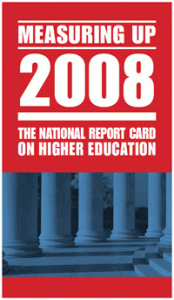CAA News Today
Troubling Study on US Higher Education
posted Dec 03, 2008
 States are making little or no progress in providing affordable college opportunities or improving college completion rates for their residents, says a report released today by the National Center for Public Policy and Higher Education. The findings come as states face massive budget shortfalls that threaten higher-education funding, and the United States continues to lag behind other advanced nations on measures of higher-education performance.
States are making little or no progress in providing affordable college opportunities or improving college completion rates for their residents, says a report released today by the National Center for Public Policy and Higher Education. The findings come as states face massive budget shortfalls that threaten higher-education funding, and the United States continues to lag behind other advanced nations on measures of higher-education performance.
Drawing on nearly two decades of data, the report, Measuring Up 2008, finds that while states have made modest gains in preparing students for college, more students are failing to graduate from high school. While college-enrollment rates for young adults are improving, enrollment rates are declining for older adults. The report also notes that the burden of paying for college is now higher for students in every state, and low college-completion rates have barely improved. Additionally, disparities persist in college access and success by income, race and ethnicity, and state.
According to the study, major gaps include:
- Affordability. The burden of paying for college has increased for all families but has increased substantially more for low- and middle-income families. Nationally, families in the lowest-income group (bottom 20 percent of the population) pay 55 percent of their income to attend public four-year colleges and universities (after accounting for all student financial aid)—a jump from 39 percent in 2000. Families in the middle-income group (middle 20 percent of the population) pay 25 percent of their income (up from 18 percent in 2000), and those in the top income group (top 20 percent of the population) pay 9 percent of their income (up from 7 percent in 2000). (See page 8 of Measuring Up 2008.)
- Additionally, college is more affordable in some states than others. At community colleges, the proportion of family income needed to pay for college expenses, after financial aid, has increased from 18 percent to 25 percent in Florida, and from 20 percent to 25 percent in Washington State. At public four-year institutions, the percentage of income needed to pay costs, after aid, has increased from 17 percent to 20 percent in Minnesota, from 19 percent to 34 percent in New Jersey, and from 29 percent to 41 percent in Pennsylvania. (See page 15.)
- High school completion. In Illinois, 95 percent of white young adults have a high school credential, compared with 82 percent of blacks. In Texas, 93 percent of white young adults have a high school credential, compared with 74 percent of Hispanics. (See page 14.)
- College attendance. In Connecticut and New York, 50 percent of white young adults are enrolled in college, compared with 34 percent of blacks. In California, 45 percent of whites are enrolled, compared with 27 percent of Hispanics. In Arizona, 40 percent of whites are enrolled, compared with 18 percent of Native Americans. (See page 14.)
- College graduation. In Delaware, 73 percent of white students complete a bachelor’s degree within six years of enrolling in college, compared with 41 percent of black students. In New York, 63 percent of whites do so, compared with 43 percent of Hispanics. In New Mexico, 47 percent of whites graduate within six years, compared with 25 percent of Native Americans. (See page 16.)
As a result of these inequities, US higher-education performance has been declining compared to other nations in recent years.
- In college completion, which has never been a strength of American higher education, the US falls in the middle of the pack: fifteenth among twenty-nine countries compared
- The US adult population ages thirty-five and older still ranks among the world leaders (second only to their peers in Canada) in the percentage who have college degrees, reflecting the educational progress of earlier times
- Among twenty-five- to thirty-four-year-olds, however, the US has slipped to tenth in the percentage having college degrees. This relative erosion of our national “educational capital” reflects the lack of significant improvement in the rates of college participation and completion in the US in recent years, compared with other countries
Measuring Up 2008 is the fifth in a series of biennial report cards issued by the National Center, based in San Jose, California. Like the earlier reports, this edition measures the performance of the nation and of each state in providing education and training beyond high school. Each state receives an A-to-F grade in each of five performance areas.
In addition to the national report card, detailed individual report cards are available for each of the fifty states. Upon release of Measuring Up 2008, the national and state report cards will be posted on the National Center’s website.
The National Center for Public Policy and Higher Education promotes public policies that enhance Americans’ opportunities to pursue and achieve a quality higher education. Established in 1998 by a consortium of national foundations, the center is an independent, nonprofit, nonpartisan organization. It is not associated with any institution of higher education, with any political party, or with any government agency. The National Center is solely responsible for Measuring Up 2008.


